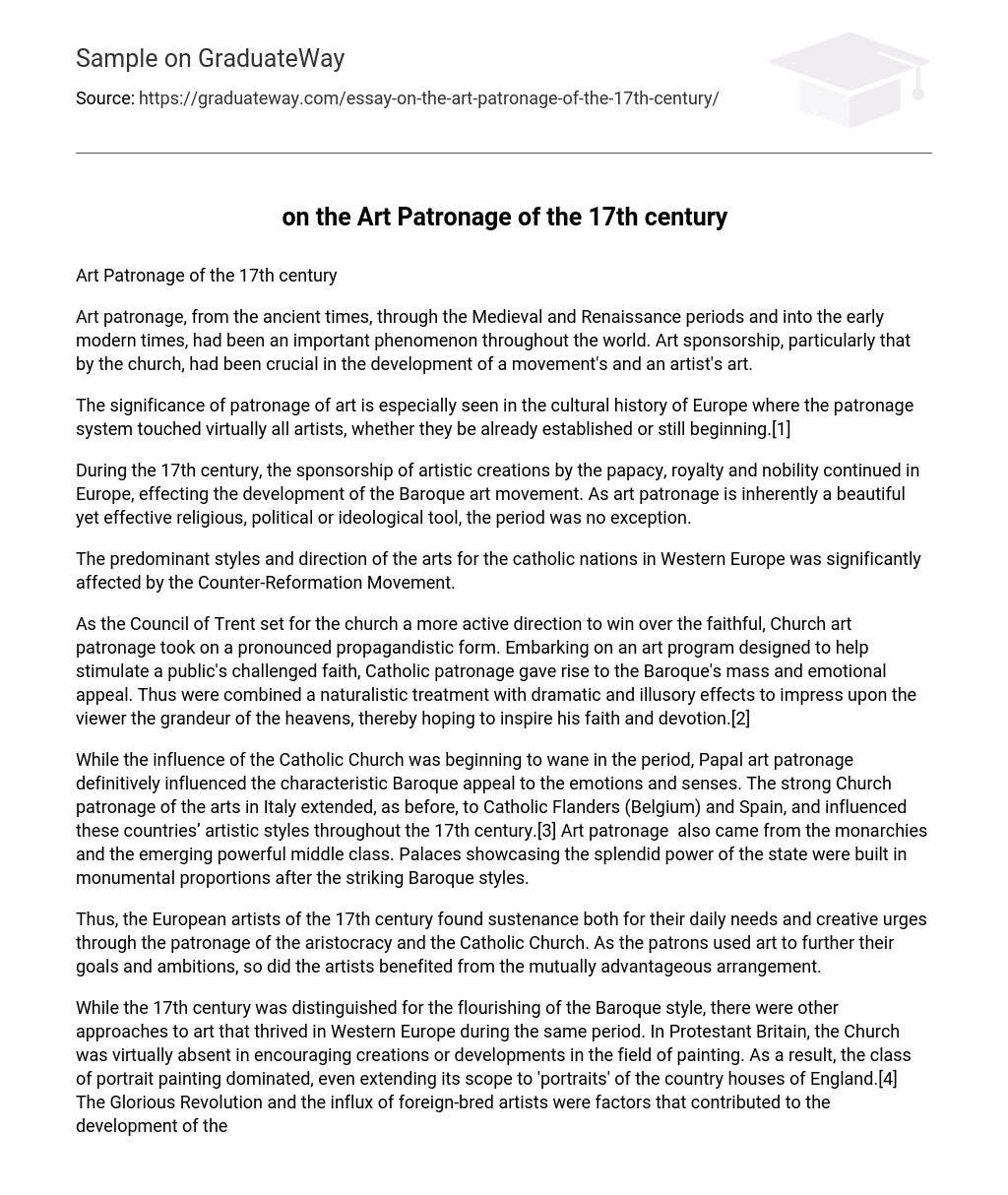Art Patronage of the 17th century
Art patronage, from the ancient times, through the Medieval and Renaissance periods and into the early modern times, had been an important phenomenon throughout the world. Art sponsorship, particularly that by the church, had been crucial in the development of a movement’s and an artist’s art.
The significance of patronage of art is especially seen in the cultural history of Europe where the patronage system touched virtually all artists, whether they be already established or still beginning.[1]
During the 17th century, the sponsorship of artistic creations by the papacy, royalty and nobility continued in Europe, effecting the development of the Baroque art movement. As art patronage is inherently a beautiful yet effective religious, political or ideological tool, the period was no exception.
The predominant styles and direction of the arts for the catholic nations in Western Europe was significantly affected by the Counter-Reformation Movement.
As the Council of Trent set for the church a more active direction to win over the faithful, Church art patronage took on a pronounced propagandistic form. Embarking on an art program designed to help stimulate a public’s challenged faith, Catholic patronage gave rise to the Baroque’s mass and emotional appeal. Thus were combined a naturalistic treatment with dramatic and illusory effects to impress upon the viewer the grandeur of the heavens, thereby hoping to inspire his faith and devotion.[2]
While the influence of the Catholic Church was beginning to wane in the period, Papal art patronage definitively influenced the characteristic Baroque appeal to the emotions and senses. The strong Church patronage of the arts in Italy extended, as before, to Catholic Flanders (Belgium) and Spain, and influenced these countries’ artistic styles throughout the 17th century.[3] Art patronage also came from the monarchies and the emerging powerful middle class. Palaces showcasing the splendid power of the state were built in monumental proportions after the striking Baroque styles.
Thus, the European artists of the 17th century found sustenance both for their daily needs and creative urges through the patronage of the aristocracy and the Catholic Church. As the patrons used art to further their goals and ambitions, so did the artists benefited from the mutually advantageous arrangement.
While the 17th century was distinguished for the flourishing of the Baroque style, there were other approaches to art that thrived in Western Europe during the same period. In Protestant Britain, the Church was virtually absent in encouraging creations or developments in the field of painting. As a result, the class of portrait painting dominated, even extending its scope to ‘portraits’ of the country houses of England.[4] The Glorious Revolution and the influx of foreign-bred artists were factors that contributed to the development of the British version of Baroque, including the short-lived blossoming of decorative painting.[5]
The surge in the decorative use of portable easel paintings in common households and the changes in the tastes of collectors of artworks also in a way accounted for the various approaches in the field. Together with the increasing activity of art dealers in selling finished works–in contrast to art creation by commissioning–and the persisting mannerist and classical styles adopted by certain artists, these factors led to a wider range of subjects, techniques and approaches and consequently, wider markets. In France and Holland, a painting market developed, marked by a taste for the realistic.[6]
It could be said that at the root of all these developments in the arts of Protestant Europe was the Protestant Reformation. With the Protestant sects refusing to utilize the art medium towards their religious aims, the road towards a secular development was set for affected countries.
References
Baroque period. Encyclopædia Britannica. Retrieved December 4, 2006, from
Encyclopædia Britannica 2006 Ultimate Reference Suite DVD.
Painting, Western. Encyclopædia Britannica. Retrieved December 4, 2006, from
Encyclopædia Britannica 2006 Ultimate Reference Suite DVD.
Patronage. (2006, December 3). In Wikipedia, The Free Encyclopedia. Retrieved 03:16,
December 4, 2006, from http://en.wikipedia.org/w/ index.php?title=Patronage&oldid=91730711.
(2003).16th and 17th Century Europe. Retrieved December 3, 2006, from The Dayton
ART Institute Web site: http://tours.daytonartinstitute.org/accessart/ connect.cfm?TN=dw09.
[1]Patronage, (2006, December 3), In Wikipedia, The Free Encyclopedia. Retrieved 03:16, December 4, 2006, from http://en.wikipedia.org/w/index.php?title=Patronage&oldid=91730711
[2] Baroque period, Encyclopædia Britannica, Retrieved December 4, 2006, from Encyclopædia Britannica 2006 Ultimate Reference Suite DVD.
[3] (2003), 16th and 17th Century Europe, Retrieved December 3, 2006, from The Dayton
ART Institute Web site: http://tours.daytonartinstitute.org/accessart/ connect.cfm?TN=dw09.
[4] painting, Western. Encyclopædia Britannica, Retrieved December 4, 2006, from Encyclopædia Britannica 2006 Ultimate Reference Suite DVD .
[5] Baroque period, Britannica.
[6] Baroque period, Britannica.





